Part of the difficulty in engineering a functional
bolt was nesting the Bulldog far enough into the Steyr receiver to achieve
the proper barrel alignment, while still retaining enough of the bolt
to allow attachment and rotation of the sleeve and cocking lever.
When placed in the proper position, the Bulldog occupies most of the
bolt cavity. 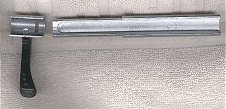
Even after I cut and trimmed the bolt and attaching
sleeve to the limit of their ability to grip each other, the Bulldog's
frame was still too large to recess up into the receiver far enough.
I found that the Bulldog's upper frame would have to be milled to fit
properly with the functioning bolt.
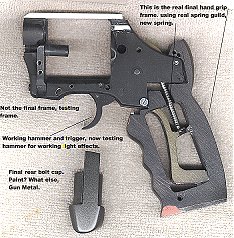
The real question was, what did the propmaker on
the film do, or perhaps, if I were in his shoes, what would I have done?
If the gun frame were to be modified heavily, would it still
be safe? Ultimately, I concluded the following:
The hero gun was to be a blank firing move prop.
Once modified, the underlying revolver would never be asked to
fire "live" rounds again. Blank rounds would reduce the compression
load to the gun and its frame considerably. Thus, all I really
would have needed to worry about was the gun’s ability to withstand
blanks. So I concluded milling down the frame should be a safe
change.
Trimming the upper cylinder support of the frame
should not weaken the revolver by much, if any, and any reduction in
strength would be more than compensated for by the lessened shock of
the blank rounds.
So, I proceeded to mill the top of the frame down
almost to the depth of the Bulldog’s rear sight groove. The sides
were then milled to the width of the hammer slot at the rear of the
frame.
These modifications were necessary to retain sufficient
the bolt material that a tube fitted to the turned down end would still
have enough circumference to grip the rod under it. The cocking
lever could then be fastened to this tube, which would in turn rotate
around the rear of the bolt as the lever is raised. By capping
the bolt just behind the lever and sleeve assembly using a casting of
the Steyr bolt end cap (with attachment provided by a small 4/40 Allen
screw), the bolt could be opened and pulled back with the same action
as the original Steyr rifle.
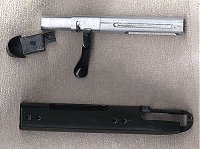 The final step in nesting the Bulldog beneath the Steyr was to
mill a round cut into the bolt for the length of the Bulldog’s replacement
barrel. I was able to use one of the scope mounting holes of
the Steyr receiver to establish a range of travel by threading a longer
set screw that extended into the milled slot, thereby controlling the
slide of the bolt and also setting its stopping point. This guide
screw then also doubled as a retaining screw to keep the bolt in the
receiver
The final step in nesting the Bulldog beneath the Steyr was to
mill a round cut into the bolt for the length of the Bulldog’s replacement
barrel. I was able to use one of the scope mounting holes of
the Steyr receiver to establish a range of travel by threading a longer
set screw that extended into the milled slot, thereby controlling the
slide of the bolt and also setting its stopping point. This guide
screw then also doubled as a retaining screw to keep the bolt in the
receiver
The stunt prop had a gun barrel that looked simply
like a heavy tube. There are no identifying marks nor any 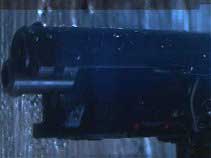 evidence of the characteristic tapering of the standard Bulldog barrel.
We have concluded that the propmaker probably cut off the front
sight from the tapered Bulldog barrel and then covered it with an aluminum
sheath. He may have cut a matching (female) taper into a longer
aluminum tube; or he may have turned down the tapered barrel to a cylindrical
barrel and then fitted a tube over it to avoid having to deal with the
taper. It is equally possible that a Target model Bulldog was
used (although this is a less common gun), which is constructed in this
very fashion from the factory. The Target model came with a heavy
aluminum sleeve manufactured to a close tolerance slip fit over a thin
steel barrel. The aluminum sleeve included a shroud around the
ejector knob and was held in place on the steel liner barrel with a
tiny set screw.
evidence of the characteristic tapering of the standard Bulldog barrel.
We have concluded that the propmaker probably cut off the front
sight from the tapered Bulldog barrel and then covered it with an aluminum
sheath. He may have cut a matching (female) taper into a longer
aluminum tube; or he may have turned down the tapered barrel to a cylindrical
barrel and then fitted a tube over it to avoid having to deal with the
taper. It is equally possible that a Target model Bulldog was
used (although this is a less common gun), which is constructed in this
very fashion from the factory. The Target model came with a heavy
aluminum sleeve manufactured to a close tolerance slip fit over a thin
steel barrel. The aluminum sleeve included a shroud around the
ejector knob and was held in place on the steel liner barrel with a
tiny set screw.
Unfortunately, even the Target model barrel is
a little short, so the propmaker still would have had to take an aluminum
tube or rod and machine it to fit over the rifled steel core.
Either way, the sleeve used would provide the needed metal to drill
and tap into for the Steyr receiver mounts and for the front ammo housing
bolt that screwed into the underside of the barrel. As a bonus,
these same screws could also help hold the outer sleeve onto the steel
liner by extending through the aluminum and set contacting the steel.
Of course, the 6/32 Allen screw serving as a front sight detail on the
Steyr could also have served this purpose
From study of the stunt props I determined that
the original prop barrel was 0.75-inch in diameter with a 500-thousandths
(.50 caliber) bore, so I used 3/4-inch acrylic tubing having 1/8-inch
wall thickness for the model’s barrel. The 60-thousandths bore oversize
relative to the .44 caliber barrel of the Bulldog gives a bit
of extra clearance. 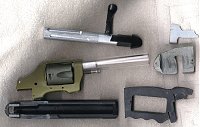
Once all of the test fitting had been worked out,
I proceeded to fabricate the prototype bolt from aluminum and to retool
the best of the primary gun components. Each part was checked
and rechecked to insure all would fit together and work in concert,
while maintaining the highest level of detail and premium finish achievable.
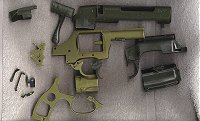
Molds and casts were made for each integrated Bulldog
component: the triggers, hammer, cylinder, cylinder swing arm (also
known as the crane), and a modified thumb latch from the Bulldog.
Similarly, molds and casts were completed for the
Steyr action, including the bare receiver, bolt end cap, ammo housing,
.222 ammo clip (also known as the magazine), and the trigger guard.
Note that the trigger guard and housing are one piece on the
original Steyr, but they were separated into two components to create
the hero prop gun.
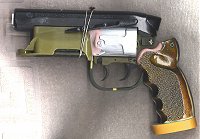 The
rest of the detailing for the master patterns had to be fashioned by
cutting up one of my existing stunt copies for the basic shapes and
details, followed by extensive recreation and sculpting of finer details
and features
The
rest of the detailing for the master patterns had to be fashioned by
cutting up one of my existing stunt copies for the basic shapes and
details, followed by extensive recreation and sculpting of finer details
and features
The master pattern for the left side cylinder cover
was made using aluminum tubing and Bondo ®. The right side was made
from three side cover castings cut and enlarged to fit, with a cylinder
clearing carved out of the underside. 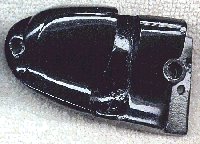
I worked very carefully on these details, using
the best stunt prop casting as a guide. Each master part was crafted
to match the fit of its companion on the stunt prop paying particular
attention to the placement of the side covers relative to details visible
on the Bulldog frame. The side covers were adjusted to match
every detail and fit on the master as compared with the solid cast stunt
prop, such as the partial covering of the trigger pins. Every aspect
was checked and rechecked to achieve a precise match.









